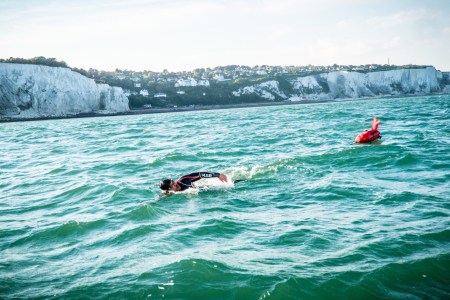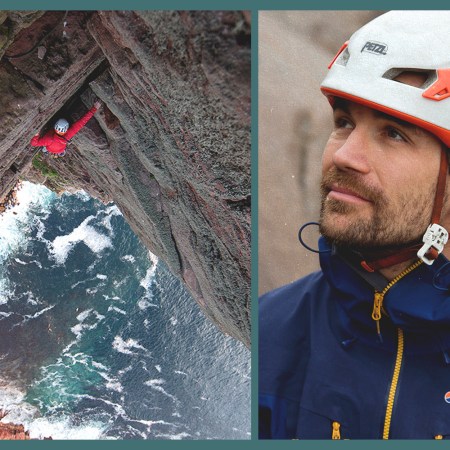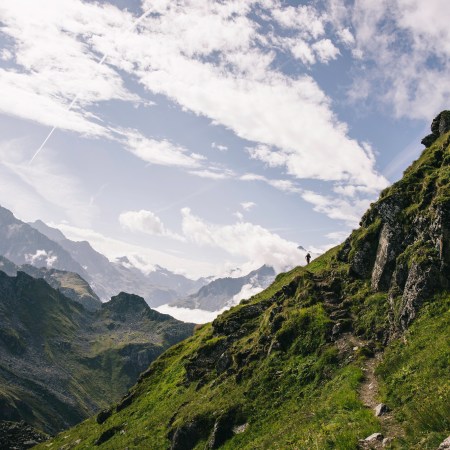This article is part of our brand-new Adventureland series, a collection of “how to” field notes from academic experts, modern explorers and endurance athletes throughout the world. From escaping bears to crossing deserts, they detail the joys of courting adventure — and their tips for surviving it.
On November 17, 2012, José Salvador Alvarenga set sail from the small fishing village of Costa Azul in Mexico. It was supposed to be a routine fishing trip. Then a five-day storm hit, wiping out the motor, most of his electronics and the fishing gear. As the seas finally calmed, Alvarenga and his boat mate Ezequiel Córdoba found themselves miles from home with no clue how to get back.
They drifted for months, drinking rainwater and eating fish, turtles and birds. Four months in, Córdoba reportedly gave up and allowed himself to starve to death. Now alone, Alvarenga signaled every passing boat, without any success.
In total, he would drift for 438 days, before eventually spotting land and swimming to shore. He had ended up on the Marshall Islands, 6,700 miles from where he’d begun, setting the record for the longest solo survival at sea.
In another famous survival story, the 58-foot sailing yacht Trashman departed Annapolis, Maryland in October of 1982 for a short sail down to Florida. A drunken captain and a massive storm combined to wreck the boat on the evening of the first day, forcing the five crew members into a lifeboat, leaving them adrift with no drinking water. On the third day, the captain began drinking seawater and, delirious, decided to swim for shore. He was immediately set upon by sharks. Another crew member went the same way, while a third died from blood poisoning brought about by injuries sustained in the boat’s sinking. Four days into their ordeal, a Russian cargo ship rescued the two survivors, Deborah Kiley and Brad Cavanagh, off Cape Hatteras in North Carolina.
Of the five on board, Kiley and Cavanagh had been the only experienced crew members and the only ones to keep their heads, just as Alvarenga would keep his own cool 30 years later.
When it comes to surviving at sea, professor Mike Tipton of the Extreme Environments Laboratory, working out of the University of Portsmouth, is somewhat of an expert. Working with everyone from military units to emergency response teams, the EEL’s job is to explore the pathophysiological and psychophysiological responses to going into extreme environments.
In other words: What happens to our bodies and minds when we find ourselves in deeply inhospitable surroundings?
Having started out as a swimmer, Tipton gained a master’s degree in Human and Applied Physiology and a Ph.D. at King’s College London. Along the way, he met the researcher Frank Golden at the Institute of Naval Medicine. Golden was exploring why people fail to survive in cold water; for Tipton, this brought together his two interests: sea swimming and temperature regulation.
“Globally, 1,000 people die in the water per day,” Tipton explains over the phone from Cornwall as Storm Kathleen brings 65 mph gales to the U.K. “But that’s an underestimation, as many are in low-income countries and the deaths don’t get properly recorded. 64% percent of them are under the age of 30, 43% under the age of 15 and a quarter of them are under five years old. If you assume that the world life expectancy is about 70 years, over 10 years that represents about 100 million years of life lost. It’s a frightening statistic and makes you want to do something about it.”
How I Swam Around the Entire Island of Great Britain
All it took? 157 days, 1,792 miles and more than a few mental pep talksAs for people actually getting lost at sea, Tipton says long survival voyages are “relatively few and far between” and that most cases occur in the tropics, where warm water gave everyone from the Bounty’s Captain Bligh in the 1780s to the Robertson family in the 1970s a good chance of survival.
“It doesn’t matter whether it’s being trapped in a cave, football teams stranded in the mountains, or people lost at sea, every scenario adheres to the same survival hierarchy,” Tipton explains. “If you have no oxygen, your survival time is measured in minutes. The next most important thing is your ability to maintain thermal balance, i.e., not get too hot or cold, where survival time is measured in hours. If you have no fluid, survival time is measured in days. If you have no food, it’s measured in weeks.”
Should you find yourself in similarly dire circumstances, Tipton shares his advice for making it out the other side.
Stay Calm
As Tipton explains, most people drown after falling into cold water due to the cold shock response: an inhale of two to three liters of air, followed by uncontrollable hyperventilation. Should that first gasp contain water, not air, it’s game over — especially as it only takes one-and-a-half liters of saltwater in the lungs to cross the lethal threshold.
“If you’re going into the water voluntarily, go in as slowly as possible,” Tipton says. Even if you’re jumping in, once you hit water, the key is to try and stay as still as possible until you regain control of your breathing, which should take about a minute. “You then have about 10 minutes in very cold water before you lose your manual dexterity,” he explains.
Get into your raft as quickly as possible, try to warm your hands and arms, and use your survival kit if you have one. If rescue is only a few hours away, you might just make it.
Take Your Seasickness Pills
It might seem counterintuitive to take a seasickness pill after your boat sinks, but it might just save your life.
“A large percentage of those who die on a life raft have seasickness,” Tipton says. “We’ve done studies looking at this and it’s because when you suffer from seasickness your blood flow to your skin increases and you lose more heat.”
There’s a mental side, too. “Seasickness makes people feel awful. I know people who’ve done maritime training sessions who have almost begged to die because they felt so awful.”
Establish Your Survival Plan
Once the situation has settled, it’s time to start thinking long-term. “Start to allocate any water, knowing that about 110 milliliters a day is the minimum to maintain kidney function,” Tipton says. “If you don’t have a reverse osmosis pump or a solar still and it isn’t raining, you can start doing things like drinking fish limbic fluid, turtle blood, fish eyes, spinal fluid. You definitely shouldn’t drink urine or diluted seawater — none of these things are going to do anything but accelerate the rate at which you dehydrate.”
Extend your water consumption by staying as still and calm as possible. Aim to shelter yourself from the sun and “make sure you’re doing things in the coolest part of the day,” he advises.
Don’t Overeat
Over a long period, fishing will save your life. But you shouldn’t start eating everything in sight straight away.
“Do nothing in the first 24 hours; don’t drink anything or eat anything,” warns Tipton. “This prompts the body to switch into conservation mode, which helps you conserve water and reduce caloric usage.”
From day two, aim to get at least 400 calories per day. Fat (say, from under the shell of a turtle) should be your main macro, as protein requires water to digest and could end up dehydrating you more quickly. “If you’ve got fluid available, by all means eat the protein,” he says. “But if you’ve got absolutely no water, you won’t die from starvation in less than about 40 to 60 days…but you’ll die from thirst much sooner.”
And no, Tipton doesn’t advise you start tucking into the bodies of the deceased members of your party.
Get Your Head in the Game
While noting that he isn’t a psychologist, over the years Tipton has noticed that the likes of special forces tend to be very focused individuals. “They have this ability — as soon as you put them into a survival situation, they’ll set a routine and work through short-term goals,” he says.
Previous experience also helps. Kiley, Cavanagh and Alvarenga were all used to being at sea, dealing with tides and swells and storms, and knew how to fish. Tipton isn’t advising you to suddenly sign on as a deckhand, but he says running through ‘what if’ scenarios before a journey could save your life. “If you have to be in a group and somebody dies, what do you do about that?” he says.
Don’t Give Up
Tipton points to survival psychologist John Leach and his idea of ‘give-up-itis’. “His argument is you shouldn’t be surprised by people surviving, you should be surprised by the fact that some people die when they don’t need to,” says Tipton.
The two Trashman crew members trying to swim for shore is a prime example. “There’s a form of learned helplessness where people give up,” he continues. “Their morale plummets, their will to survive plummets and they die much sooner than they should.”
Things like seeing a rescue helicopter fly nearby and miss you might exacerbate the condition. Just as Alvarenga floated past numerous ships without being rescued, it’s important to stay positive.
Prepare for Rescue
Tipton points out that there’s more tech in the skies and on our persons than ever before, so your chances of getting rescued should theoretically be higher than ever. That said, “hope for the best but plan for the worst and assume that you’re going to be on a long voyage,” Tipton advises.
“To some extent, your chances will depend on where you are, where the shipping lanes are, etc. We’ve seen survival at sea for many, many months, so there’s no reason why you can’t do that with the correct planning.”
The key mistake people make, according to Tipton, is to buy all of the right survival gear then stow it away without ever looking it at, without familiarizing themselves with how it all works, or giving any thought to those “what if” scenarios.
“There’s a reason why professionals do lots of training in survival techniques, because it makes you much more effective when the real thing comes along,” he says. “Leach talks about three different types of people in a survival scenario: those who are queuing at the checkout as the supermarket is on fire, those who freeze and do nothing, and those who act appropriately.” For your sake, train to be the latter.
Whether you’re looking to get into shape, or just get out of a funk, The Charge has got you covered. Sign up for our new wellness newsletter today.



















